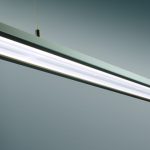Tunable Lighting: How to Improve Student Performance Like a Switch

Tunable Lighting: How to Improve Student Performance Like a Switch
Picture this: A frustrated schoolteacher, struggling to get their students’ attention, turns the classroom lights off to calm her students.
Later, the same teacher flickers the lights to get the class’s attention and let them know it’s time to start a different lesson.
To create a pleasant, warm environment, some teachers install table lamps at individual desks to better accommodate certain learning tasks.
You probably don’t have to envision any of this. You’ve seen it yourself—in person, from your childhood, or today, in your kids’ schools.
But imagine if the instructor could do these lighting techniques, plus increase student satisfaction and their academic performance, with a single lighting system?
It can be done—with your lighting design.
When it comes to designing classrooms today, architects and designers know that lighting is no longer just about giving adequate illumination so that students can see the board from the back of the class or the book or tablet screen in front of them.
Today, lighting is all about feeling, which directly and indirectly impacts students’ capability to focus during an exam, pay close attention to instruction in class and engage with their work.
Changing the Future of Our Classrooms with Light
Remember the cold, sometimes sterile classrooms that many of us set foot in so many years ago, the one that felt very institutional?
Those days are gone. Classrooms have evolved.
Today, they’re collaborative workspaces where students share ideas, work together and learn from one another. Teachers use electronic instruments like tablets, iPads and smartboards during lessons. Even the furniture is different. Flexible, multifunctional furniture is all the rage.
With all these changes, it only makes sense that classroom lighting and controls would change too. The old, reliable toggle on/off switch no longer meets the unique lesson plans taking place today.
Alternatively, LEDs have giftwrapped the lighting capabilities and controls teachers need to make students feel good, think well and achieve more.
School districts and higher learning institutions worldwide have been dealing with a variety of educational and economic challenges for several years, shrinking budgets, increased costs and higher academic requirements included.
Simultaneously, schools and universities alike are increasingly competing for students, donors, funding, more resources and even higher brand status.
In response, administrators and educators are looking high and low for strategies to trim costs, enhance services and improve student learning simultaneously. Not many initiatives can do all that.
But tunable white LED lighting can.
In recent years, LED lighting has delivered high marks across the board, and as the technology improves, the benefits—energy savings included—continuously get better.
Here’s why.
How Tunable White Lighting Works
At its most basic level, tunable white lighting is light that complements our natural circadian rhythms and mimics the sun.
For the past century, lighting—from fixtures and device screens—has significantly impacted our circadian rhythms. Electric light has liberated us from having to live by the sun.
It’s also opened a universe of health issues.
With tunable white lighting systems, electric light can be the solution to the problem it created.
Tunable white lighting adjusts to our daily rhythms by automatically changing the intensity and color temperature throughout the day.
This light tuning can improve concentration and cognitive functions while enhancing health and well-being and reducing disruptions to circadian rhythms and sleep cycles.
This is because our brains are hard-wired to naturally follow a roughly 24-hour schedule, with approximately eight hours spent sleeping. For most people, the sleeping period begins around 10 p.m. and continues to the morning. The natural cues we get from the sun keep our bodies on track and circadian rhythms fully functional through melatonin secretion or suppression.
Let’s Count the Ways: How Lighting Affects Us
Various kinds of light impact us differently.
Blue-light—like that of a blue-sky sunny day, bright cell phone screen, or cool white electric light—suppresses melatonin secretion.
On the flip side, warmer light—like candlelight and dim incandescent light—acts just like the setting sun and tells our bodies to start getting ready for sleep.
Therefore, sleep experts advise against using devices like smartphones and laptops right before bed, as they emit intense blue light that can disrupt your sleep cycle.
Thanks to LED technology and LED lighting controls advancements, we can now harness artificial light to the sun and create more natural light exposure indoors.
The ideal schedule of light exposure varies depending on what you want to achieve, but as a general rule, it would feature bright, cool light in the morning and gradually dim and warm over the day (perhaps with a cool light boost after lunch).
White tunable lighting is the ability to control a light source’s color temperature output to emulate natural patterns of sunlight.
Color temperature can be used to accentuate mood or energize people—promoting wakefulness during the day and sleep at night. This taps into the fundamental principle that blue light stimulates, and red/amber lights relax.
The Promise of Tunable White For Classroom Lighting
The connection between learning and daylight is a well-established one.
In 1999, a daylighting study done in a group of California schools found a link between increased daylight and higher test scores. It also found a link between sunlight and more positive moods among teachers and students.
The takeaway was that daylighting and maximizing exposure to natural light is crucial to any academic application’s design because of lighting’s impact on our attention spans, focus, mood, and circadian rhythm.
Unfortunately, because of site constraints, many libraries, communal areas, student centers, and classrooms receive little natural light or natural light.
Think about your traditional classroom, which tends to be a small space beneath a gridded ceiling. A few light switches near the door control the fluorescent troffers above. There’s little natural light. The artificial lighting quality is subpar or average at best, and there’s probably some flickering. When there’s a speech or presentation, the teacher spends a couple of minutes flipping switches up and down, trying to find the right illumination.
These challenges, plus the addition of high-tech learning tools like tablets, have made experts look deeper into designing systems that mimic natural light and give educators’ easy-to-use, flexible controls to establish the optimal lighting conditions for each teaching task.
Tuning Behavior with Tunable Light in the Classroom
With LED tunable lighting, a teacher can instantly have a multifunctional learning environment optimized for their students and any activity.
For focus-centric tasks like test-taking and essay writing, instructors can select cool-white intensive lighting to boost students’ short-term concentration and alertness.
The teacher can then dim the room’s backlights so that all eyes divert to the front for student presentations.
The perfect dimness can be achieved with just the hit of a button to minimize glare on projected screens, and so that everyone can see their notes during lectures.
A teacher can even use a warmer white light to create a more relaxing atmosphere after recess, ensuring students are calm, pay attention and that their eyes naturally adjust.
Look at this way: Remember back in school when the teacher would wheel in a TV cart with a VHS or DVD player attached? It instinctively changed our behaviors.
A teacher brightening and intensifying their classroom lights to an energetic 5000K and then dimming them a warm, easygoing 2700K creates the same automatic, subconscious response.
It already has. Anecdotal evidence—domestically and internationally—is reaching a crescendo.
Bottom line: A simple classroom lighting change can make a sweeping difference not only in a school district’s bottom line and energy expense but in the quality of its learning environment.
As classrooms evolve, designers and architects are keeping the benefits of a well-lit space first in mind.
If you have more questions, we have more answers:
- “5 Proven Ways LED Lighting Saves Schools A Ton of Money”
- “How Upgrading Your Classroom Lights Could Help You Become Teacher of the Year”
- “How Lighting Boosts Productivity: 4 Things Designers Should Know”

